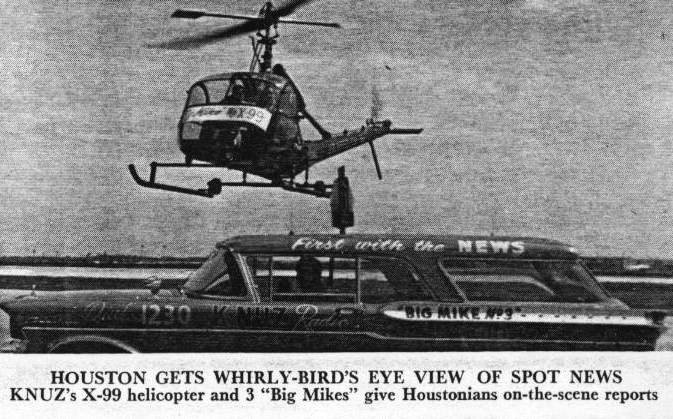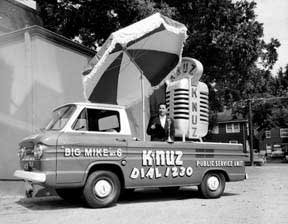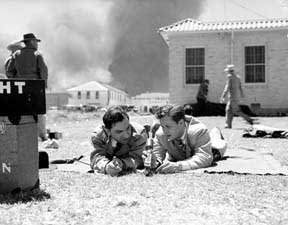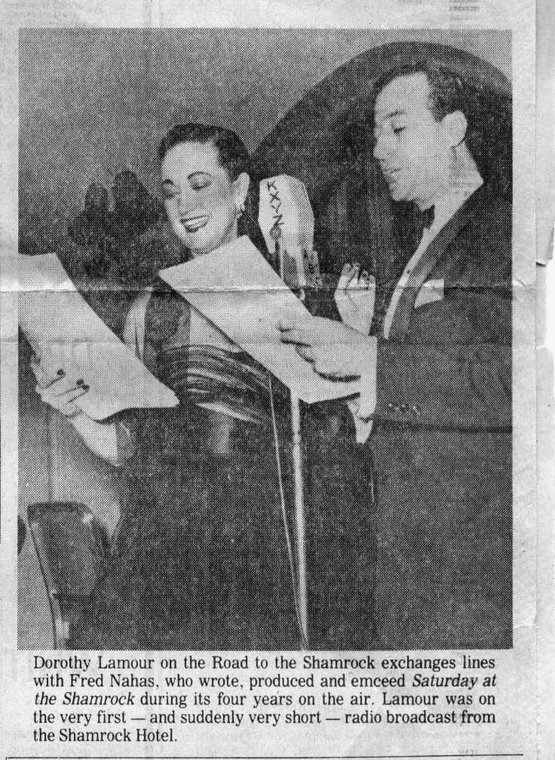Milt Willis, 1929 - 2005
He was born Milton T. Willis in Houston; raised in Montrose, he graduated from Lamar High School, class of 1948, and went off to the Navy. While stationed in Hawaii he met and married his wife and they returned to Houston and raised a family of four children. He was known to family and his closest friends as Milton but to hundreds of thousands of listeners over the years and most of the hundreds of other broadcasters he came in contact with, he was just Milt.
I have not been able to pin down when he first got into radio but for the most part he was associated with KTHT, KXYZ and KODA. Except for a very brief stint in Rapid City, SD, he spent all his career in Houston radio and in addition to air work he did a lot of voice work for advertising agencies and film production companies. I first have a record of him at KTHT, listed as program director, on a music survey in August, 1959. He was also one of the deejays as were Jack London and Larry Kane. He would have been in his late 20s by then and with a voice like his he had undoubtedly been receiving admonitions all his life that ‘you should be in radio,’ so undoubtedly he got his start some years earlier. He would not likely have been a Program Director in his first job, either. Good friend Gene Arnold remembers him at KTHT and says he had worked earlier at KXYZ where Gene had also worked although not at the same time.
Arnold remembers Milt did the morning show at KTHT and hated the shift. One time when he was interviewing a new over-night talent for KTHT that Arnold had referred he told the man he’d have to be willing to hang around some mornings until 6:15 or 6:30 when Milt couldn’t make it on time, a condition the prospective hire was not happy about. By 1960 he had found another solution to that problem; a KTHT survey published in June of that year shows him working a split shift - 8 to 10 am and 2 to 4 pm.
In the late 50s, KTHT went by the moniker Downbeat, using Ray Conniff’s ‘S Wonderful’ as an hourly ‘downbeat’ to the launch the programming. The Chronicle had reported in June, 1958, that Robert D. Strauss’s Texas Radio had purchased KTHT from Roy Hofheinz and it appears to have been a few months later when the Downbeat moniker began appearing in the listings. Gene doesn’t know for sure but doesn’t think Milt was responsible for coming up with the programming.
The station was sold again in 1961, the formal transfer of ownership to Winston-Salem Broadcasting occurring in March. The incoming owners installed new programming they called Red Carpet Radio and GM Sam Bennett resigned.
Three months later, in early June, Public Radio Corp. of Houston took control of KXYZ-AM and FM from NAFI Corporation of Los Angeles. Public Radio was composed of Lester Kamin of Houston, an advertising executive who had himself been a deejay in the 1940s, his brothers Max of Houston and Morris of Victoria. They also owned stations in Tulsa and Kansas City. They named Sam Bennett as new GM and Milt Willis as PD. GM Cal Perley and PD Ken Collins were out and would later team up again at KFMK. Collins told Houston Post columnist Bill Roberts he found out he was no longer PD of KXYZ when he read it in the newspaper.
During the early 1960s, KXYZ-AM and FM were outstanding radio stations. In an era when the GM of another big Houston station described the city as just a big over-grown country town, KXYZ presented the city as sophisticated and cosmopolitan. A big key to the imaging were the stagers which introduced musical segments with glowing audio pictures of the city. I still think of the KXYZ of that era as one of the best sounding Houston radio stations of all time. Gene Arnold doesn’t know much about the years Milt Willis was at KXYZ and does not know if he was responsible for the programming concept but his voice was ubiquitous on the station.
In April,1965, Billboard Magazine reported in a market spotlight on Houston radio that Milt was still PD of KXYZ but in January of the next year reported he had been upped to Operations Manager and a new programmer, Bob Winsett of San Francisco, was moving in. By June of 1966 Milt moved over to KODA as PD; Don LeBlanc was upped to Operations at KODA and yet another new PD was named at KXYZ.
Milt continued as Program Director of KODA for some years. Another Billboard Market profile in March of 1967 shows him still in the post but sometime between that time and the time I joined KODA in October, 1974, Milt accepted an offer from a station in Rapid City, South Dakota. I remember him telling me the call letters and I remember they were just one letter different that KODA - I believe it was KOTA. He realized almost immediately it was a mistake and he stayed a very short time. He called GM Martin Griffin at KODA and asked to return, Griffin asked the staff and it was agreed they would welcome him back. This may have been when he transitioned into sales. By the time I got to KODA in ‘74 he was Sales Manager, having moved into that chair when Tom Hoyt was upped to General Manager not long before.
I worked as an announcer in the same building with Milt for four years until Tom Hoyt named me Operations Manager to replace the departing Jason Williams. Just a few months later Hoyt left and Paul Taft promoted Milt to General Manager and then just a few months after that, Taft sold KODA-AM and FM to Westinghouse, Group W. Milt and I worked together for the next three years to try to build KODA from an also-ran for years in the beautiful music war with Harte-Hanks’ KYND. We talked everyday, went to lunch together often, but I wasn’t into radio history at that time and never asked about his career even though I had been aware of him since the 1950s.
We sometimes shared bits of our personal lives, though. I knew he collected movie theater lobby cards. One Monday I remember him looking very bedraggled and I asked why. It turned out he had spent the whole weekend on puddle-jumper flights to South Carolina and back to pick up some prized cards and he was beat. He was as proud as a new Daddy of the cards he had scored, telling me all about them and their significance, but he vowed never to do that again. I also remember him sometimes beaming on a Monday morning after a weekend jaunt to the casinos in Louisiana where he apparently regularly did quite well.
Gene Arnold shared a passion for collecting movie lobby cards and got Milt into the hobby and they went to conventions together. Gene says Milt liked to linger at the airport lounge and he warned him repeatedly he was going to miss a flight sooner or later but it was Arnold who almost missed a flight when he mistakenly boarded a flight to Seattle and didn't discover the mistake until the last minute. Gene says he and Milt also enjoyed betting against each other on college football games.
Success in the Beautiful Music format on FM depended a lot on external advertising, chiefly on TV and billboards, to get the call letters across, since so much listening to that format was done at very low, background levels. Harte-Hanks KYND had always had a much bigger advertising budget than KODA but when Westinghouse came to town, the tables were turned. By the end of 1982, KODA's ratings success was so complete, Harte-Hanks pulled the plug on KYND and turned the frequency over to their wildly successful AM, KKBQ, the successor to KTHT and KULF on 790.
In February of 1983, just a little over a month after KYND called it quits, Milt was promoted to National Sales Manager of Group W’s Texas stations and he finish his long career in Houston radio with Westinghouse.
Personal Postscript: Milt lasted longer than I with Group W. I clashed with the consultant Westinghouse assigned to their FM stations, all of which at that time were struggling except for KODA. Finally I gave up and left. The book that covered my last months as PD was the first one in KODA's history when it edged KYND but I was not there for the celebration. I talked to Milt only once after leaving but some 20 years later, sometime in the first decade of this century, I was coming back from Austin on I-10 and decided to pull into the San Felipe de Austin State Historical site in Austin Co., the unofficial capital of Stephen F. Austin’s original colony. I had known about the place since the 7th grade when every Texas school child took a Texas history course but I had never visited. The town was an important commercial center before independence and hosted several important meetings leading up to the Texas Revolution. I walked around the grounds soaking up Texas history and as I stepped into a meeting hall, an audio track started playing. It was Milt’s voice. Son-of-a-gun, I thought, This guy is everywhere. I wonder how many other state historical sites have audio tracks voiced by Milt?
I am indebted to Laura Willis Hixon for the pictures above and to her and Gene Arnold for details of Milt’s life and career and their personal remembrances of him.



























































